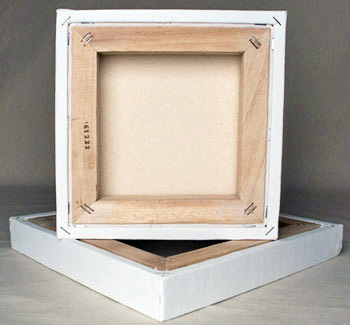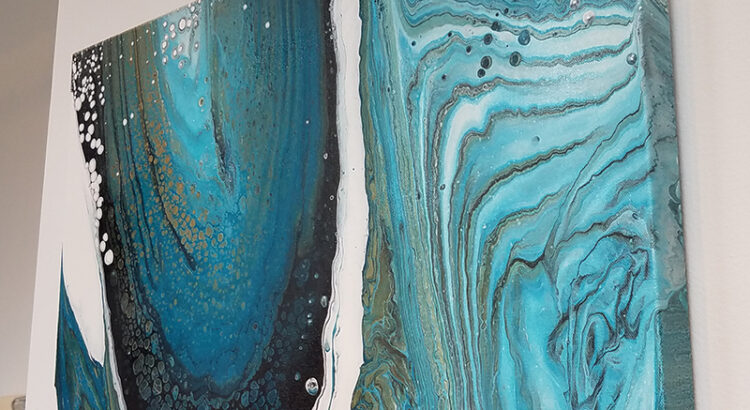If you bring paintings to art shows, you’ve probably heard about terms such as stretched canvas, gallery wrap canvas, and framed canvas. Just what is a gallery wrap canvas, how does it relate to framed and unframed canvas, and why does it matter?
Let’s start with how a canvas typically works. The canvas painting surface is stretched around a wooden frame and then stapled to it to keep the canvas stationary. Here’s a view from the back and side. The front is simply a white canvas surface.

Typically an artist paints the front canvas surface. The artwork is then ready to prepare for displaying at an art show or gallery.
The way most paintings are shown in art shows or galleries involves frames. The frame provides a complementary highlight to the artwork within. It also makes the artwork easier to handle and hang. Here is a beautiful example of “Hydrangeas in Blue” – an oil painting by Carol Frieswick within a gold frame.

Carol painted this image with oil paints on a canvas. The frame then hides the sides of the canvas. For the buyer, it doesn’t matter at all what those sides of the canvas look like. All the buyer sees is the front face.
However, frames can be REALLY expensive, so sometimes artists choose to showcase just the canvas itself, without a frame. In this case, most galleries require the canvas to be gallery wrapped. This means there are NO staples or other impediments on the four sides (top, bottom, left, right) of the canvas. Because of this, the artist can paint their image on all four sides to create a professional appearance.
Here are some examples of gallery-wrapped canvas with side-wrapped paint applied to all four sides. The finished sides allows the full piece to be hung on a wall as-is without a frame. The paintings are by Maggie Hart (blue abstract), Michele St. Pierre (lighthouse and koi pond), and Carole Plante (dog and swarming fish). Click on each image for full titles and details.
Click on any of these images to get more details about it.
The key with gallery wrap is to carry your image AROUND the edge so that the painting can be seen from all angles. This gives the painting a finished look.
It’s good to be aware that some art galleries won’t accept gallery-wrapped, side-painted artwork. They consider this style of art “unfinished”. They require all paintings to be within frames. If you are planning to submit art to a show, or approach a gallery, be sure to know their rules.
For the Blackstone Valley Art Association, we do allow gallery wrap canvas, with the edges painted. We do not allow raw canvas paintings that leave the sides completely bare and visible.
Ask with any questions!





